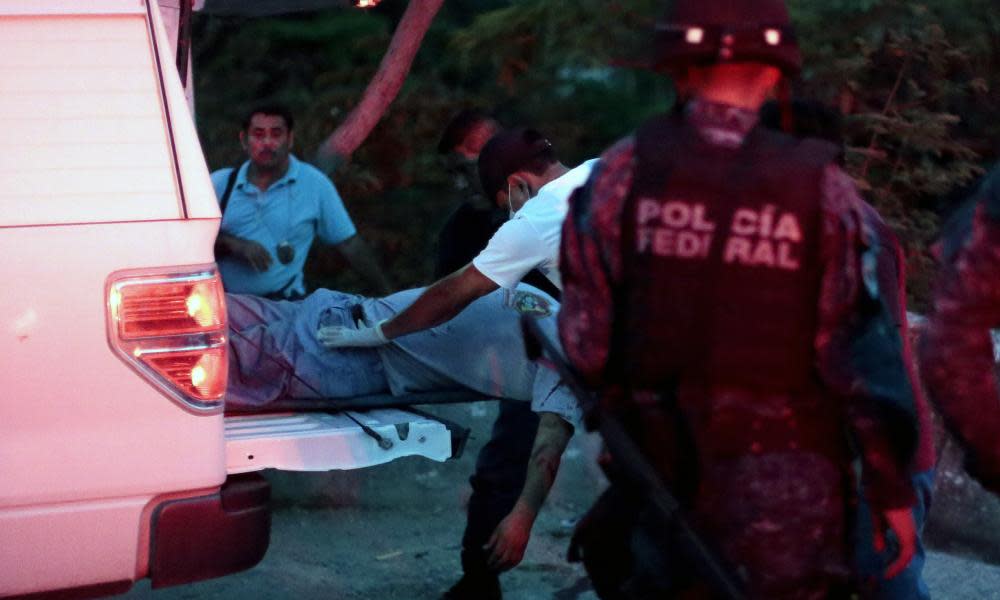Mexicans outraged after officials leave trailer full of corpses on outskirts of city

Mexicans have reacted with outrage after authorities in the western state of Jalisco left a trailer full of decomposing corpses on the outskirts of Mexico’s second-largest city following a wave of violence which overwhelmed local morgues.
Locals in the Guadalajara suburb of Tlajomulco complained to police after they were alerted to the presence of the trailer by the stench.
“This affects our kids, it smells horrible and the longer it stays it’s going to stink even worse,” Patricia Jiménez told Reuters.
It soon emerged that the trailer had previously been parked by officials in the suburb of Tlaquepaque, but was moved on orders of the mayor.
It has now been moved to an industrial area near the state attorney general’s office, according to news reports.
Why did Mexico launch its war on drugs?
On 10 December 2006, president Felipe Calderón, launched Mexico’s war on drugs by sending 6,500 troops into his home state of Michoacán, where rival cartels were engaged in tit-for-tat massacres.
Calderón declared war eight days after taking power – a move widely seen as an attempt to boost his own legitimacy after a bitterly contested election victory. Within two months, around 20,000 troops were involved in operations across the country.
What has the war cost so far?
The US has donated at least $1.5bn through the Merida Initiative since 2008, while Mexico has spent at least $54bn on security and defence since 2007. Critics say that this influx of cash has helped create an opaque security industry open to corruption at every level.
But the biggest costs have been human: since 2007, around 230,000 people have been murdered and more than 28,000 reported as disappeared. Human rights groups have also detailed a vast rise in human rights abuses by security forces.
As the cartels have fractured and diversified, other violent crimes such as kidnapping and extortion have also surged. In addition, hundreds of thousands of people have been displaced by violence.
What has been achieved?
Improved collaboration between the US and Mexico has resulted in numerous high-profile arrests and drug busts. Officials say 25 of the 37 drug traffickers on Calderón’s most-wanted list have been jailed, extradited to the US or killed, although not all of these actions have been independently corroborated.
The biggest victory – and most embarrassing blunder – under Peña Nieto’s leadership was the recapture, escape and another recapture of Joaquín “El Chapo” Guzmán, leader of the Sinaloa cartel.
While the crackdown and capture of kingpins has won praise from the media and US, it has done little to reduce the violence.
How is the US involved?
Mexico’s decade-long war on drugs would never have been possible without the huge injection of American cash and military cooperation under the Merida Initiative. The funds have continued to flow despite growing evidence of serious human rights violations.
The Jalisco state attorney general’s office has not commented, but an official in the office said the trailer was properly refrigerated and never “abandoned”.
The office also disputed press reports the trailer contained 157 corpses, with sources telling local media the number was closer to 100.
Jalisco’s general secretary Roberto López told local media that the state’s morgue had been overwhelmed by a surge in deaths, adding that a new morgue should be finished in a month and a half. “When it is built, these bodies will be transferred,” he said.
The row over the trailer – which erupted as the country celebrated its national day on Sunday – was yet another reminder of the grim toll from the country’s decade-long drug war.
Mexico’s homicide rate hit a record high in 2017 with 29,168 murders registered. The country recorded 2,599 homicides in July 2018, its most murderous month since 1997, when Mexico started keeping such statistics.
It was not the first time that the bloodletting has been so severe that local morgues have run out of space – similar incidents have occurred in the opium heartlands of Guerrero.
But the gruesome episode in Guadalajara has underlined how violence has spread to all corners of the country. The surrounding Jalisco state has deteriorated rapidly in recent months: 15 people were injured in May when a gun battle erupted in the city centre after a brazen assassination attempt on the state’s employment secretary.
In March, three film students in the Guadalajara suburb of Tonalá disappeared after unwittingly filming property associated with a drug trafficker when they were working on a college project.
Much of the violence in the region is the work of the Jalisco New Generation Cartel (CJNG) which has disputed territories across the country – especially those controlled by the rival Sinaloa Cartel, whose former leader Joaquín “El Chapo” Guzmán was extradited to the United States last year.
More recently, CJNG has itself splintered into rival factions. In July, US and Mexican officials announced that had raised the reward to $1.56m for information leading to the arrest of the CJNG boss Nemesio Oseguera Cervantes, known as “El Mencho”.

 Yahoo News
Yahoo News 
